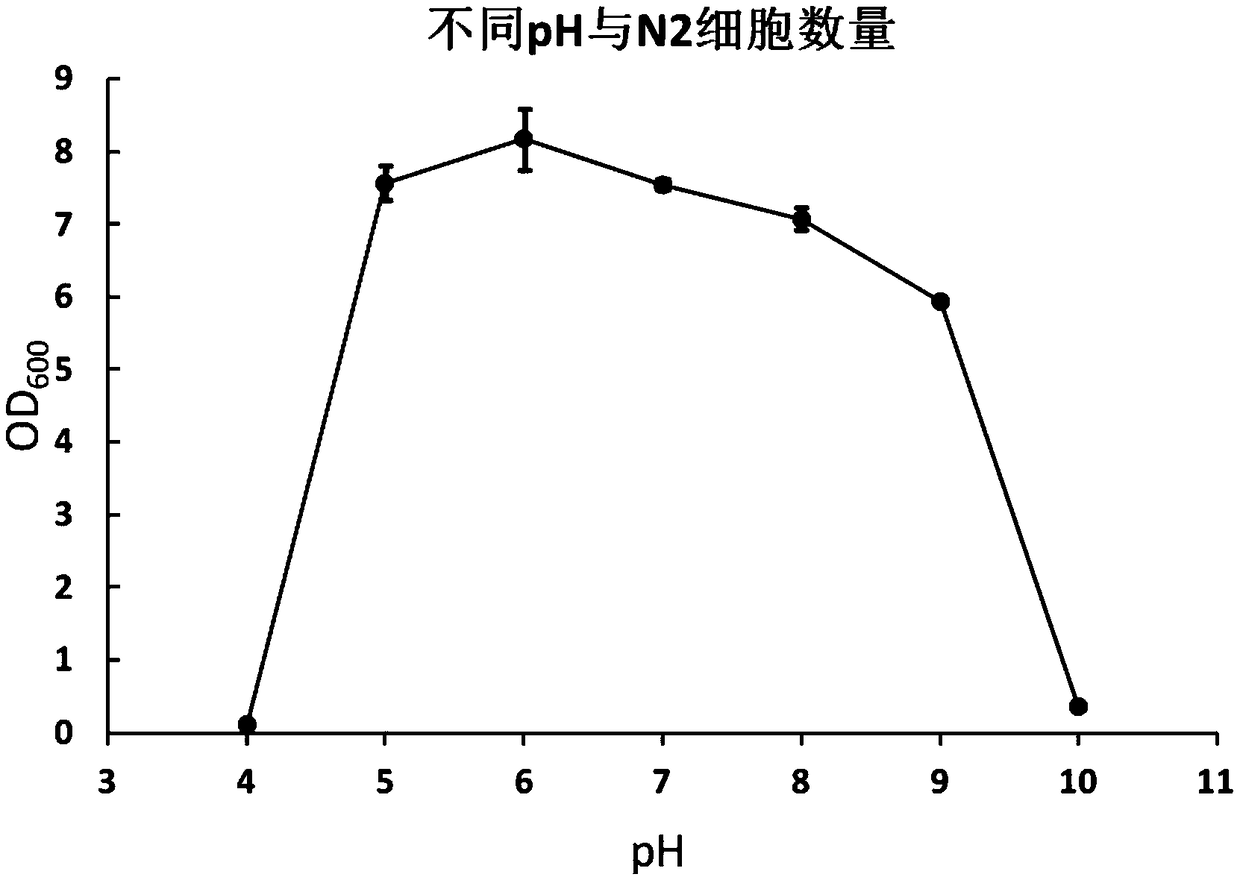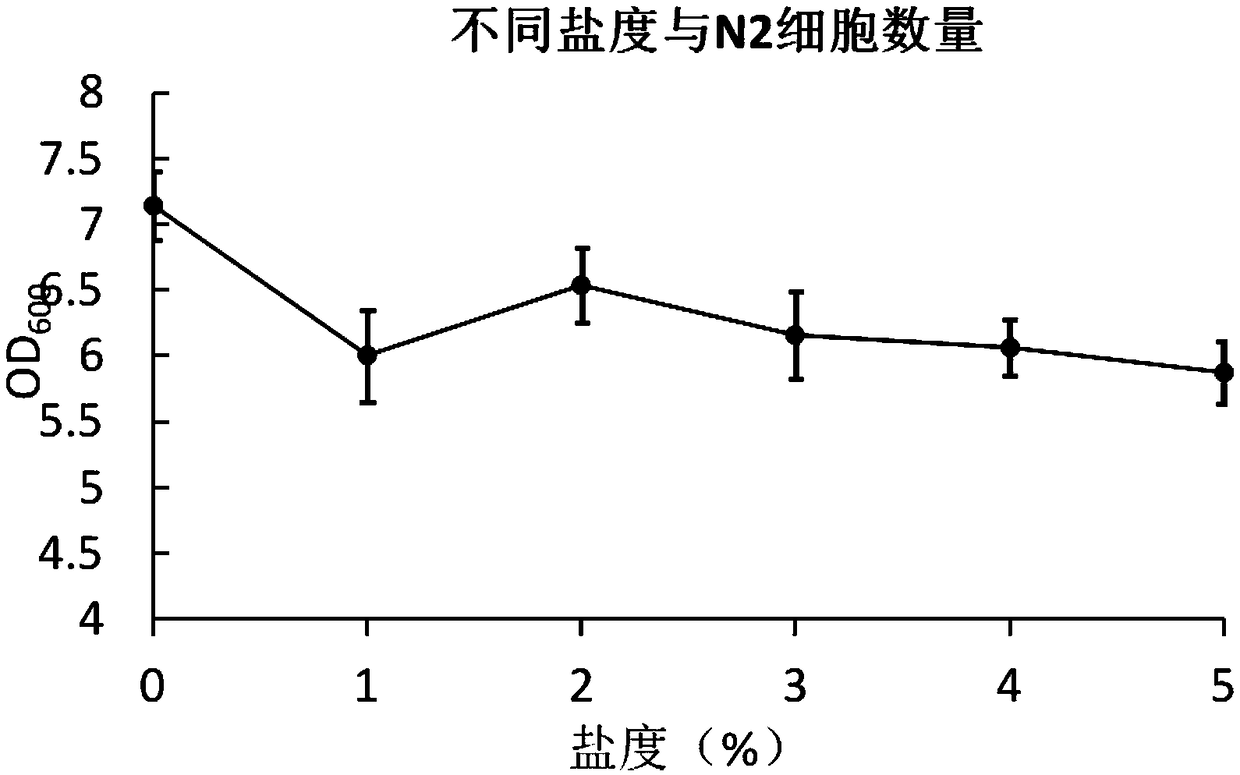Bacillus subtilis N2 with ammonia nitrogen degradation function and application thereof
A Bacillus subtilis, ammonia nitrogen technology, applied in the field of microorganisms, can solve the problems of lack of scientific and rigorous technical guidance, unstable quality, long starting time, etc., and achieve the effects of good application prospects, wide tolerance and strong adaptability
- Summary
- Abstract
- Description
- Claims
- Application Information
AI Technical Summary
Problems solved by technology
Method used
Image
Examples
Embodiment 1
[0021] Example 1 Enrichment and screening of Bacillus subtilis N2 with the function of reducing ammonia nitrogen
[0022] Sample source: Litopenaeus vannamei (Litopenaeus vannamei) cultured water body in the breeding house of South China Sea Institute of Oceanology, Chinese Academy of Sciences.
[0023] The specific implementation steps are as follows: under sterile conditions, inoculate the prawn culture water body into a 250mL Erlenmeyer flask containing 100mL liquid screening medium with an inoculum size of 1% v / v, place it in a shaker at 200rpm and culture at 30°C for 48h ; Take 100 μL of the culture solution and spread it on the solid screening medium, cultivate it in a 30°C incubator for 24 hours, pick a single colony, and inoculate it again in the liquid screening medium for pure culture, after 36 hours of pure culture, take the culture solution and dilute it 10 times The ammonia nitrogen content in the culture solution was measured, and the strain with the best effect ...
Embodiment 2
[0027] The identification of embodiment 2 bacillus subtilis N2 bacterial classification
[0028] 1. Morphological observation
[0029] The pure culture strains were inoculated on the surface of 2216E solid medium according to the plate streaking method, and cultured in a 30°C incubator for 24 hours to observe the morphological characteristics of the colonies. See the photo of N2 strain colony figure 1 , the colony is dot-shaped, opaque white, with smooth edges and raised colonies.
[0030] The 2216E solid medium is prepared by adding agar powder with a mass fraction of 1.5% to the 2216E liquid medium components and mixing. The 2216E liquid medium contains 5g of peptone per liter, 1g of yeast extract powder, 0.1g of ferric citrate, 19.45g of sodium chloride, 5.98g of magnesium chloride, 3.24g of sodium sulfate, 1.8g of calcium chloride, and 0.55g of potassium chloride , sodium carbonate 0.16g, potassium bromide 0.08g, strontium chloride 0.034g, boric acid 0.022g, sodium sili...
Embodiment 3
[0040] Example 3 Exploration of Bacillus subtilis N2 Optimum Growth Conditions
[0041] The effects of different pH, temperature and NaCl mass fraction (salinity) on the growth of Bacillus subtilis N2 were studied respectively. Among them, the different temperatures are: 20°C, 25°C, 30°C, 37°C, 43°C; the different pH values are: 4.0, 5.0, 6.0, 7.0, 8.0, 9.0, 10.0; the different NaCl mass fractions are: 0 %, 1%, 2%, 3%, 4%, 5%.
[0042] In the above experiments, except for the investigation factors, the fermentation conditions were all to inoculate the Bacillus subtilis N2 culture solution in the LB fermentation medium with an inoculum size of 1% (v / v), and after cultivating for 24 hours at 30°C and 200rpm, samples were taken to measure each Conditional OD 600 Value, the LB fermentation medium without inoculation was used as blank control. Take culture temperature, pH value, NaCl mass fraction as abscissa, OD 600 Values plot the respective curves on the ordinate. see r...
PUM
| Property | Measurement | Unit |
|---|---|---|
| Lc50 | aaaaa | aaaaa |
Abstract
Description
Claims
Application Information
 Login to View More
Login to View More - R&D
- Intellectual Property
- Life Sciences
- Materials
- Tech Scout
- Unparalleled Data Quality
- Higher Quality Content
- 60% Fewer Hallucinations
Browse by: Latest US Patents, China's latest patents, Technical Efficacy Thesaurus, Application Domain, Technology Topic, Popular Technical Reports.
© 2025 PatSnap. All rights reserved.Legal|Privacy policy|Modern Slavery Act Transparency Statement|Sitemap|About US| Contact US: help@patsnap.com



